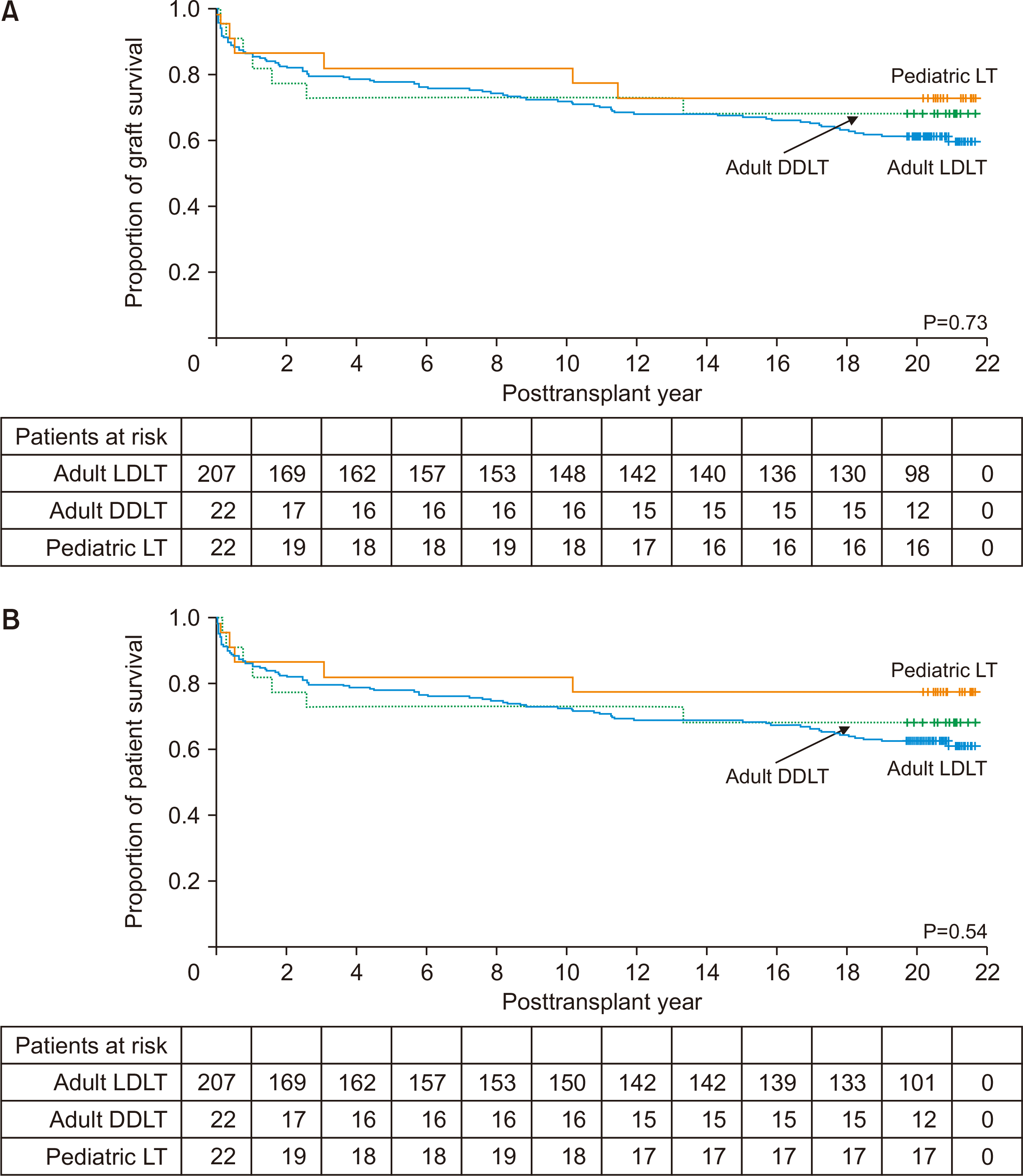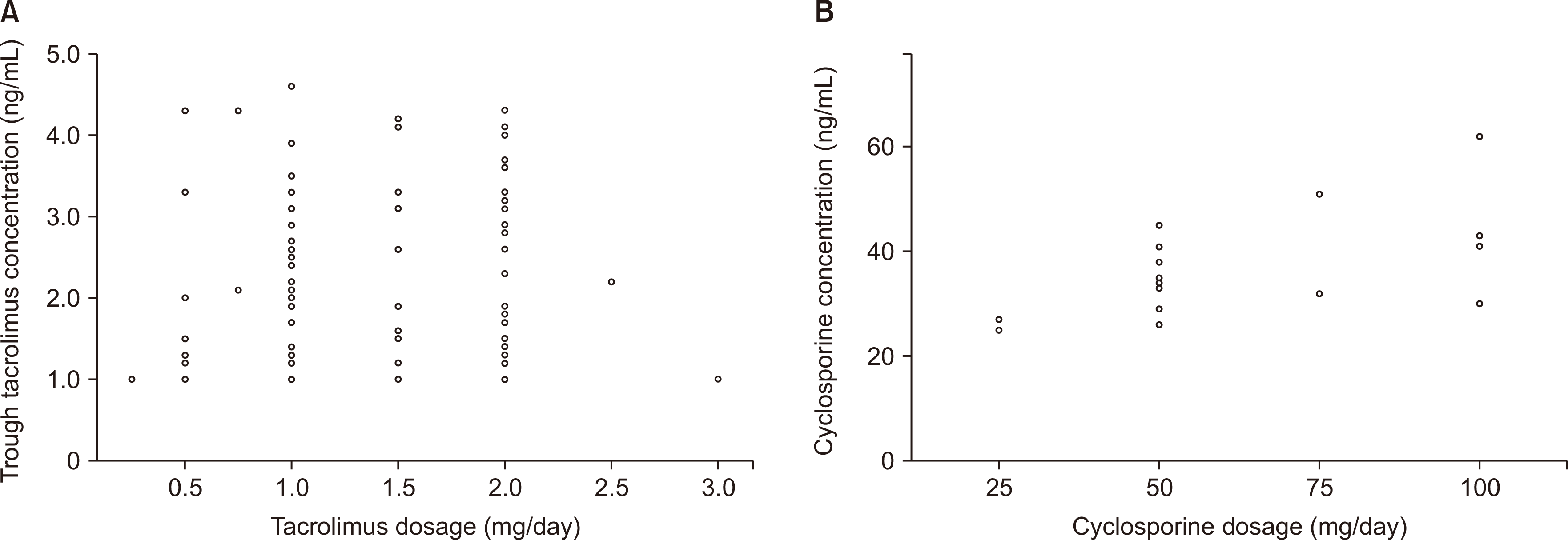1. Adam R, Karam V, Delvart V, OʼGrady J, Mirza D, Klempnauer J, et al. 2012; Evolution of indications and results of liver transplantation in Europe: a report from the European Liver Transplant Registry (ELTR). J Hepatol. 57:675–88. DOI:
10.1016/j.jhep.2012.04.015. PMID:
22609307.

2. Kim WR, Lake JR, Smith JM, Skeans MA, Schladt DP, Edwards EB, et al. 2015; OPTN/SRTR 2013 annual data report: liver. Am J Transplant. 15 Suppl 2:1–28. DOI:
10.1111/ajt.13197. PMID:
25626341.

3. Dopazo C, Bilbao I, Castells LL, Sapisochin G, Moreiras C, Campos-Varela I, et al. 2015; Analysis of adult 20-year survivors after liver transplantation. Hepatol Int. 9:461–70. DOI:
10.1007/s12072-014-9577-x. PMID:
25788182. PMCID:
PMC4473278.

5. Firl DJ, Sasaki K, McVey J, Hupertz V, Radhakrishnan K, Fujiki M, et al. 2019; Improved survival following living donor liver transplantation for pediatric acute liver failure: analysis of 20 years of US National Registry data. Liver Transpl. 25:1241–50. DOI:
10.1002/lt.25499. PMID:
31119826.
6. Hwang S, Ha TY, Ahn CS, Moon DB, Kim KH, Song GW, et al. 2016; Standardized surgical techniques for adult living donor liver transplantation using a modified right lobe graft: a video presentation from bench to reperfusion. Korean J Hepatobiliary Pancreat Surg. 20:97–101. DOI:
10.14701/kjhbps.2016.20.3.97. PMID:
27621745. PMCID:
PMC5018955.

7. Jung D, Hwang S, Ahn C, Moon D, Ha T, Song G, et al. 2021; Quilt unification venoplasty of the right hepatic veins enabling double inferior vena cava anastomosis in living donor liver transplantation using a right liver graft. Ann Liver Transplant. 1:86–94. DOI:
10.52604/alt.21.0004.

8. Jung D, Hwang S, Song G. 2021; Selection criteria of living donor liver transplantation for hepatocellular carcinoma developed in Korean transplant centers. Ann Liver Transplant. 1:29–47. DOI:
10.52604/alt.21.0005.

9. Min SI, Ahn C, Han DJ, Kim SI, Chung SY, Lee SK, et al. 2015; To achieve national self-sufficiency: recent progresses in deceased donation in Korea. Transplantation. 99:765–70. DOI:
10.1097/TP.0000000000000412. PMID:
25226175.
10. Hwang S, Lee SG, Lee YJ, Sung KB, Park KM, Kim KH, et al. 2006; Lessons learned from 1,000 living donor liver transplantations in a single center: how to make living donations safe. Liver Transpl. 12:920–7. DOI:
10.1002/lt.20734. PMID:
16721780.

11. Jung BH, Hwang S, Song GW, Jung DH, Ha TY, Park GC, et al. 2015; Updated status of deceased-donor liver graft allocation for high-urgency adult patients in a Korean high-volume liver transplantation center. Transplant Proc. 47:580–3. DOI:
10.1016/j.transproceed.2015.02.014. PMID:
25891690.

12. Kim SH, Hwang S, Ahn C, Moon D, Ha T, Song G, et al. 2021; Absence of influence of the Korean MELD score-based liver allocation system on pretransplant MELD score in patients undergoing living donor liver transplantation. Ann Liver Transplant. 1:10–17. DOI:
10.52604/alt.21.0003.

13. Hwang S, Lee SG, Ha TY, Ahn CS, Park KM, Kim KH, et al. 2004; Simplified standardized technique for living donor liver transplantation using left liver graft plus caudate lobe. Liver Transpl. 10:1398–405. DOI:
10.1002/lt.20241. PMID:
15497157.

14. Lee SG, Song GW, Yoon YI. 2019; An exceptional series: 5000 living donor liver transplantations at Asan Medical Center, Seoul, Korea. Transplantation. 103:1739–41. DOI:
10.1097/TP.0000000000002708. PMID:
31461082.

15. Kang SH, Hwang S, Ahn CS, Kim KH, Moon DB, Ha TY, et al. 2020; Changes in the indications for living donor liver transplantation: single-institution experience of 3,145 cases over 10 years. Korean J Transplant. 34:47–54.
16. Hwang S, Lee SG, Ahn CS, Kim KH, Moon DB, Ha TY, et al. 2008; Prevention of hepatitis B recurrence after living donor liver transplantation: primary high-dose hepatitis B immunoglobulin monotherapy and rescue antiviral therapy. Liver Transpl. 14:770–8. DOI:
10.1002/lt.21440. PMID:
18508369.

17. Hwang S, Ahn CS, Song GW, Kim KH, Moon DB, Oh HB, et al. 2011; Posttransplantation prophylaxis with primary high-dose hepatitis B immunoglobulin monotherapy and complementary preemptive antiviral add-on. Liver Transpl. 17:456–65. DOI:
10.1002/lt.22226. PMID:
21445929.

18. Hwang S, Song GW, Chung YK, Ahn CS, Kim KH, Moon DB, et al. 2019; Determination of hepatitis B immunoglobulin infusion interval using pharmacokinetic half-life simulation for posttransplant hepatitis B prophylaxis. J Korean Med Sci. 34:e251. DOI:
10.3346/jkms.2019.34.e251. PMID:
31583871. PMCID:
PMC6776838.

19. Park GC, Hwang S, Kim MS, Jung DH, Song GW, Lee KW, et al. 2020; Hepatitis B prophylaxis after liver transplantation in Korea: analysis of the KOTRY database. J Korean Med Sci. 35:e36. DOI:
10.3346/jkms.2020.35.e36. PMID:
32056398. PMCID:
PMC7025905.

21. Hwang S, Namgoong JM. 2021; Tailored techniques of graft outflow vein reconstruction in pediatric liver transplantation at Asan Medical Center. Ann Liver Transplant. 1:58–70. DOI:
10.52604/alt.21.0006.

22. Hwang S, Namgoong JM. 2021; Tailored standardization of portal vein reconstruction for pediatric liver transplantation at Asan Medical Center. Ann Liver Transplant. 1:71–78. DOI:
10.52604/alt.21.0007.

23. Oh SH, Jeong IS, Kim DY, Namgoong JM, Jhang WK, Park SJ, et al. Recent improvement in survival outcomes and reappraisal of prognostic factors in pediatric living donor liver transplantation. Liver Transpl. 2021; Sep. 18. [Epub].
https://doi.org/10.1002/lt.26308. DOI:
10.1002/lt.26308. PMID:
34536963.

24. Park HW, Hwang S, Ahn CS, Kim KH, Moon DB, Ha TY, et al. 2012; De novo malignancies after liver transplantation: incidence comparison with the Korean cancer registry. Transplant Proc. 44:802–5. DOI:
10.1016/j.transproceed.2012.01.027. PMID:
22483500.

25. Jung DH, Hwang S, Song GW, Ahn CS, Moon DB, Ha TY, et al. 2016; Survival benefit of early cancer detection through regular endoscopic screening for de novo gastric and colorectal cancers in Korean liver transplant recipients. Transplant Proc. 48:145–51. DOI:
10.1016/j.transproceed.2015.12.003. PMID:
26915860.

26. Park GC, Hwang S, Ahn CS, Kim KH, Moon DB, Ha TY, et al. 2020; Pretransplant hepatic malignancy increases risk of de novo malignancy after liver transplantation. J Korean Med Sci. 35:e69. DOI:
10.3346/jkms.2020.35.e69. PMID:
32193900. PMCID:
PMC7086089.

27. Hwang S, Ahn CS, Kim KH, Moon DB, Ha TY, Song GW, et al. 2018; A cross-sectional analysis of long-term immunosuppressive regimens after liver transplantation at Asan Medical Center: increased preference for mycophenolate mofetil. Ann Hepatobiliary Pancreat Surg. 22:19–26. DOI:
10.14701/ahbps.2018.22.1.19. PMID:
29536052. PMCID:
PMC5845607.

28. Kang S, Hwang S, Ha T, Song G, Jung D, Ahn C, et al. 2019; Cross-sectional analysis of immunosuppressive regimens focused on everolimus after liver transplantation in a Korean high-volume transplantation center. Korean J Transplant. 33:98–105. DOI:
10.4285/jkstn.2019.33.4.98.





 PDF
PDF Citation
Citation Print
Print





 XML Download
XML Download